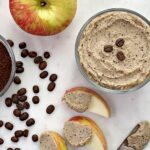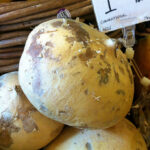 Jicama (pronounced hee-kah-ma) is an edible root that resembles a turnip. It is part of the legume family and is also known as a yam bean, Mexican turnip, or Mexican potato. Jicama is in season from December to June.
Jicama (pronounced hee-kah-ma) is an edible root that resembles a turnip. It is part of the legume family and is also known as a yam bean, Mexican turnip, or Mexican potato. Jicama is in season from December to June.
Jicama has thin brown skin and crisp, juicy, white flesh that is mild in flavor. It’s flavor resembles a cross between a water chestnut and a pear.
Storage
When picking one at the store you want to choose a firm, round jicama that is smooth with no dings or mold. Once home, store in a cool, dark place for up to 4 weeks. Store cut jicama in the refrigerator.
Preparation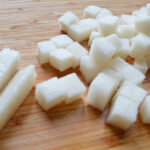
Wash the jicama and then remove the peel (as if you were peeling a potato or skinning an apple). Cut the white flesh into cubes or strips, according to your recipe. Jicama does not brown or become soggy after cutting, so it makes a nice addition to crudité platters and salads. It is also good added raw to sushi rolls in place of cucumber for crunch, or included in stir-fries, since like water chestnuts it does not lose it’s crispiness when cooked.
Eating
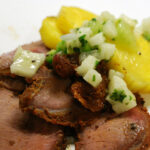
Jicama is very versatile! You can eat it raw or cooked and make it sweet or savory. Sliced and baked, chopped, cubed, sliced into fine sticks, raw or cooked, jicama is versatile and great in stir-fries, salads, slaw, soup, and with other veggies and fruits like oranges, apples, carrots, and onions, as well as meats and seafood.
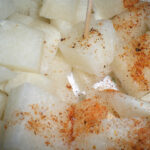
Jicama’s mild taste makes it a perfect complement to a variety of flavors. My favorite ways to enjoy jicama include:
- Chilled, jicama slices sprinkled with chili powder, lime juice and a dash of salt
- Placing them on a cookie sheet and baking them in the oven like fries
- Raw jicama dipped in salsa (healthier version of chips and dip)
- Diced or thinly sliced in a salad or fruit salad
Nutrition Benefits
Jicama is low calorie (50 calories per cup), practically fat-free, low sodium, high fiber (6 grams fiber per cup), high in potassium and an excellent source of vitamin C. Jicama also contains important vitamins like folate, riboflavin, pyridoxine, pantothenic acid, and thiamin, and the minerals calcium, magnesium, copper, iron, and manganese.
Rich in vitamin C – 44% of the daily value per serving. Because of jicama’s high vitamin C content, it is great for boosting the immune system, supporting eye and skin health, reducing inflammation.
Jicama has very low sodium, hardly any fat (around .01% of polyunsaturated fat per one medium jicama), and is high in potassium (around 989 milligrams for one medium root) all of which supports heart health and maintenance of a healthy weight.
The soluble fiber in jicama is excellent for lowering cholesterol, stabilizing blood sugar levels and boosting digestive health.
Jicama is also rich in iron which is responsible for making sure red blood cells have enough oxygen, and helps to boost our energy levels.
Jicama contains vitamin B-6 (pyridoxine), which supports healthy brain functioning, and helps our body to break down protein into usable energy. Vitamin B-6 also supports nerve functioning, helps to form red blood cells, and helps to synthesize antibodies that fight foreign viruses and bacteria in our body.



